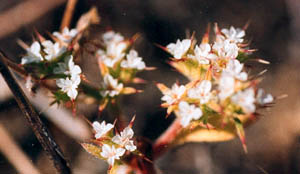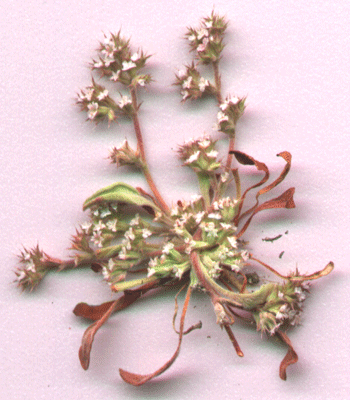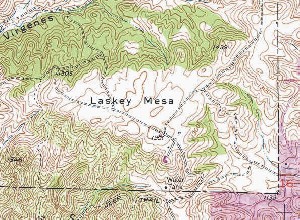CALIFORNIA NATIVE PLANT SOCIETY
Channel Islands Chapter
Channel Islands Chapter
Rare Plant Profiles:  Chorizanthe parryi var. fernandina
Chorizanthe parryi var. fernandina
 Chorizanthe parryi var. fernandina
Chorizanthe parryi var. fernandina
Its bioregional distribution included: South Coast (to Orange County), eastern Western Transverse Ranges, and San Gabriel Mountains. It has been extirpated from the Los Angeles Basin, including the Type Locality in San Fernando.


This variety of spineflower was thought to be extinct, having not been seen since 1929, until it was rediscovered accidentally on the Ahmanson Ranch development site in southeastern Ventura County. It was presumed to be extinct by CNPS and botanists until June of 1999 when botanist Rick Reifner found it at a previously unreported locale on Laskey Mesa in the Simi Hills of Ventura County, just north of Calabasas. It has also been found at several locations on Newhall Ranch near Valencia/Castaic Junction area just east of the Ventura County line on the foothills of the Santa Susana Mountains.
Listed Endangered
A petition to the California Fish and Game Commission to list the SFVS as an endangered species was considered at the Commission’s June 2000 meeting in Truckee. The petition was commissioned by the City of Calabasas and prepared by LSA Associates, an environmental consulting firm. David Magney represented CNPS to express support for making the plant an endangered species. The Commission voted to make it a candidate for listing, which represents a one-year review period to gather information on the plant before a decision is made on whether or not to list it. Candidate status under the California Endangered Species Act gives the plant full protection under the law, as if it were listed. The SFVS was discovered on Laskey Mesa near Calabasas in the very southeastern corner of Ventura County, on the Ahmanson Ranch development site. The Ahmanson Ranch developers (a subsidiary of Washington Mutual Bank) have plans to develop the site where this annual plant lives. The SFVS had not been seen previously for 60 years. Repeated attempts at gain access to Ahmanson Ranch and Newhall Ranch to see the plant and its environs have been unsuccessful. Washington Mutual would not let anyone but a few agency biologists access to their property, and Newhall doesn’t let anyone on there property except consultants sworn to absolute secrecy.
By September 2001, the California Fish and Game Commission finally formally voted to list the SFVS as an endangered species. The Commission did this at their hearing in Santa Barbara on 23 August 2001, after a 1-year review while the Spineflower was a candidate. David Magney testified before the Commission on behalf of CNPS to urge them to list this plant as endangered.
Laskey Mesa Population Preserved
In the end, Washington Mutual saw that development of Ahmanson Ranch wasn't wanted by citizens in the area, and developing it was not in their best interest, politically, so they fired the VP in charge of Ahmanson and sold the Ahmanson Ranch to the Santa Monica Mountains Conservancy, for a profit, of course. Regardless, this important part of Ventura County, with a large population of SFVS is now preserved forever! The Santa Monica Mountains Conservancy has named these lands the Upper Las Virgenes Canyon Open Space Preserve.

CHANNEL ISLANDS CHAPTER, CALIFORNIA NATIVE PLANT SOCIETY, PO Box 6, Ojai, CA 93024-0006
Special thanks to Carlin Moyer for the beautiful illustrations on our site.
Last updated: 3 September 2008
For website comments: webmaster(at)cnpsci(dot)org
For website comments: webmaster(at)cnpsci(dot)org
CNPS HOME | SITE MAP | CHANNEL ISLANDS CHAPTER HOME